

PRÉSENTATION GÉNÉRALE
Vous voici face au monument ossuaire de la Sablière, le premier érigé en hommage aux soldats de l’armée française lors de la guerre franco-allemande de 1870-1871, et intimement lié aux combats s’étant déroulés ici le 11 octobre 1870. Si vous voulez davantage d’informations historiques, vous trouverez un panneau d’information devant le monument.
Mais alors, pourquoi une earthcache à cet endroit ??? Et bien, la roche utilisée pour la fabrication de la stèle n’est pas du tout commune dans notre région… elle nous vient de la chaîne des Puys, en Auvergne-Rhône-Alpes !
LA CHAÎNE DES PUYS
La Chaîne des Puys est un alignement de 80 volcans qui s’étend sur près de 32 kilomètres de long et 4 kilomètres de large.
Chaîne des Puys
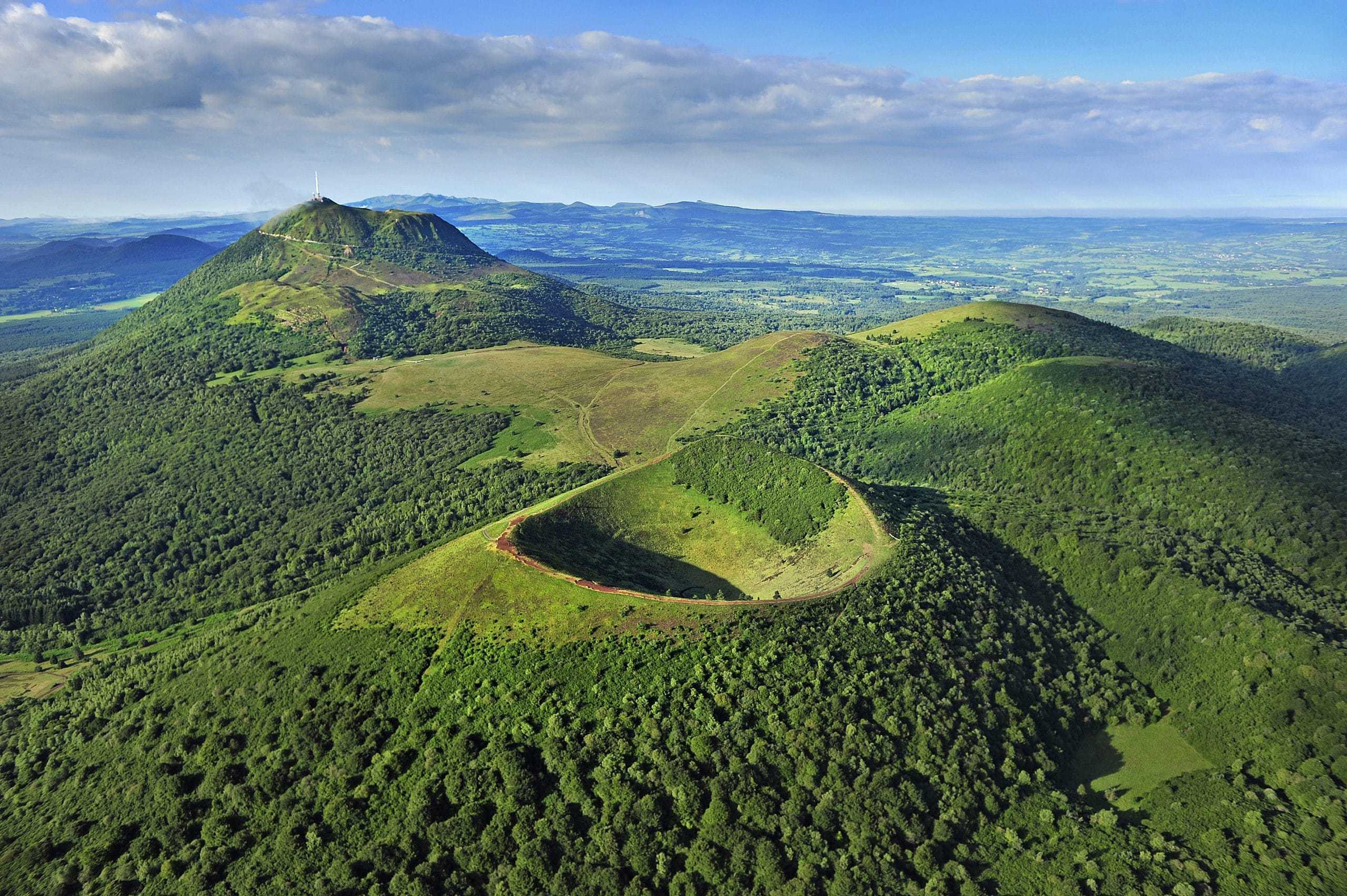
En contrecoup de la formation des Alpes, la croûte terrestre s'est amincie créant ainsi de vastes fissures sous l’Auvergne. Les roches ont alors fondu par endroit et ont formé du magma. Et c’est par ces fissures qu’il est remonté à la surface, créant ainsi des volcans. Formée entre 95 000 et 8 400 ans, la chaîne des puys constitue l’ensemble volcanique le plus jeune de France métropolitaine. C’est justement parce que ces volcans sont jeunes, qu’ils proposent une grande variété de formes. Les volcans de la Chaîne des Puys n’ont pas eu le temps de s’éroder, leurs formes sont restées pures et facilement interprétables.
Culminant à 1465 mètres, le Puy de Dôme est le plus élevé d’entre eux, mais c’est à un autre Puy que nous nous intéresserons pour cette earthcache...
LE PUY DE NUGÈRE
Le Puy de Nugère est situé au Nord de la chaîne des puys, et culmine à 994 mètres d’altitude. Il est le résultat d’une succession d’éruptions volcaniques qui se sont produites il y a environ 11 000 ans, et qui en fait un édifice géologique complexe.
- A l’origine, ce puy est constitué de 3 cônes stromboliens (des volcans de la forme la plus répandue : projections et coulée de lave autour d’un cratère) (Figure 1)
- Mais une explosion magmatophréatique (rencontre de l’eau avec le magma) pulvérise partiellement le principal de ces 3 cônes (figure 2), et un lac de lave apparaît dans le cratère qui a subsisté.
- Le lave du lac se répand ensuite aux alentours, en direction de Volvic (figure 3), et de petits cônes stromboliens (de nouveaux volcans) s'installent sur la surface solidifiée du lac de lave, produisant de nouvelles coulées.
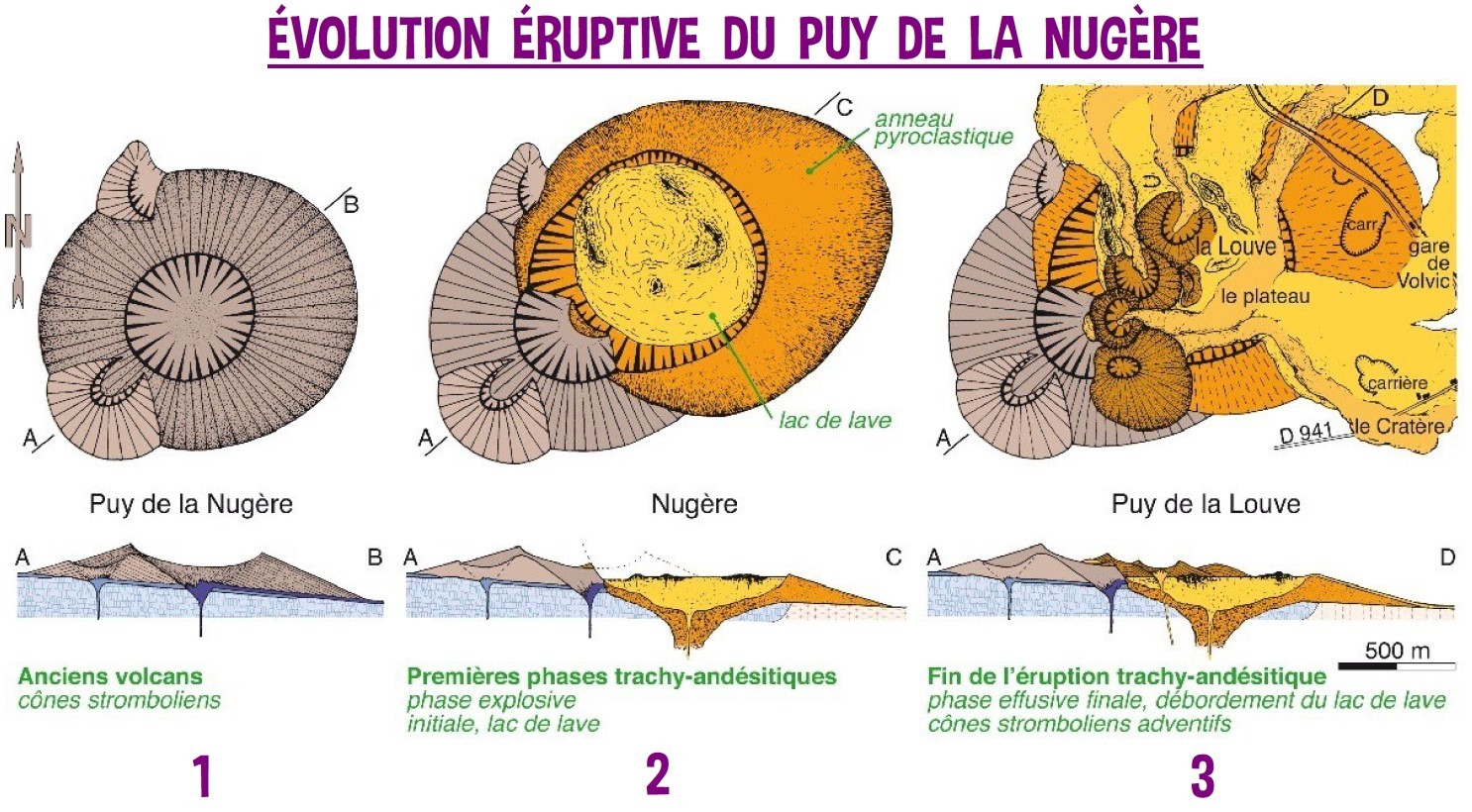
Et c’est cette coulée de lave vers Volvic qui nous intéresse !
LA PIERRE DE VOLVIC
Pour être précis, cette gigantesque coulée est une « trachy-andésite », c’est à dire une roche volcanique de la série alcaline, intermédiaire entre un trachybasalte et un trachyte. C’est un peu complexe pour le cadre de cette earth que je souhaite accessible, alors visons plus simple…
La pierre de Volvic est une pierre de lave, caractérisée par sa couleur grise. Son aspect n’est pas commun, car de petites bulles de gaz emprisonnées lors du refroidissement ont laissé des imperfections qui troublent finement son caractère lisse.
Pierre de Volvic
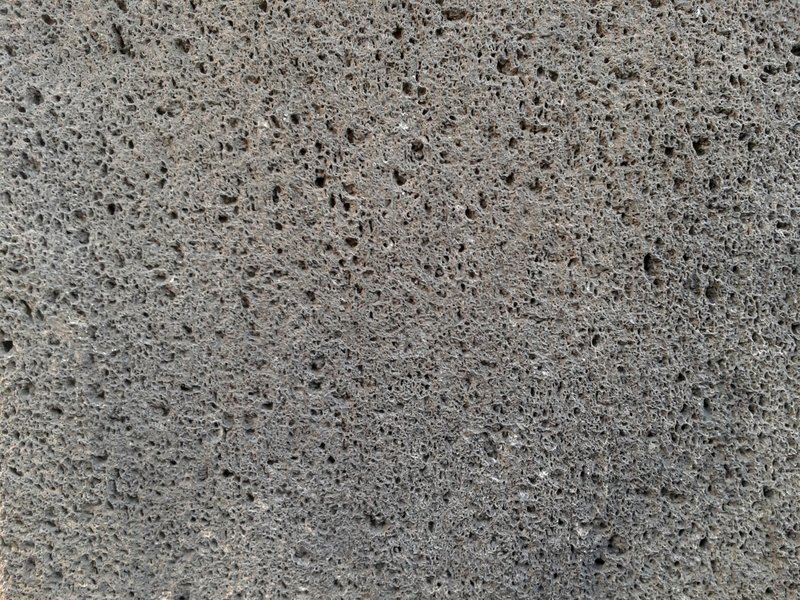
Outre son apparence, cette pierre est unique par sa substance : indestructible, elle résiste à l’eau, au gel, au feu, à la compression, à la putréfaction et aux acides. Elle présente aussi un faible coefficient de dilatation. Cela en fait un matériau de choix pour les constructions ou pour les sculptures. Les petits trous des bulles de gaz la rendent par ailleurs facile à découper, à tailler et à sculpter. Et bien qu’elle soit légère et poreuse, elle n’est pas fragile pour autant. Cela peut paraître étonnant, mais elle n’éclate pas quand on la travaille...
UTILISATION DE LA PIERRE DE VOLVIC
- Les qualités citées précedemment ont naturellement poussé les auvergnats à utiliser cette roche dans la construction de bâtiments. Son exploitation remonte au XIIIème siècle, avec en particulier l'édification de la cathédrale de Clermont-Ferrand, ou plusieurs bâtiments symboliques de la ville de Riom. Au XIXème siècle, l'exploitation de la pierre de Volvic s'intensifie et s'exporte. Elle est par exemple utilisée comme bordure de trottoirs à Paris.
Cathédrale de Clermont-Ferrand
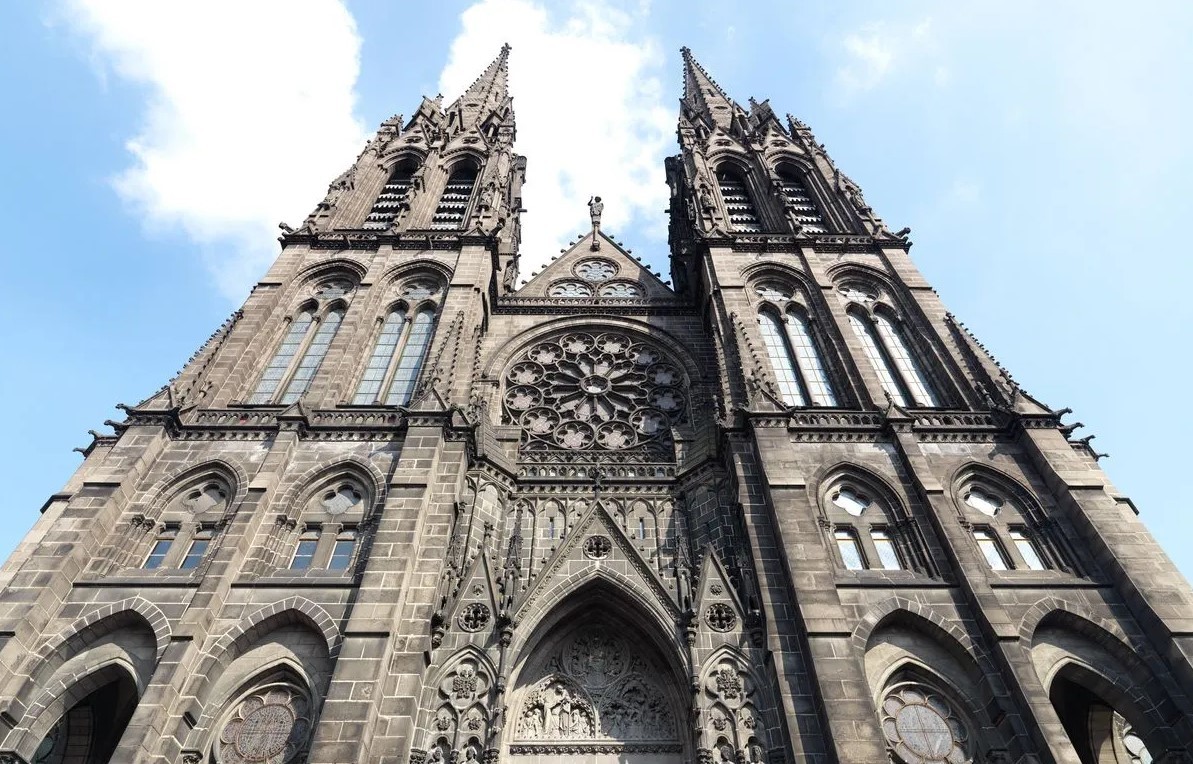
- La pierre de Volvic est par ailleurs très appréciée des sculpteurs pour sa texture et sa dureté. Elle a servi la création d'oeuvres en tout temps, et est encore utilisée aujourd'hui par des artistes comme l'artiste Thierry Courtadon qui en a fait son support fétiche.
Sculptures en Pierre de Volvic

Thierry Courtadon à gauche et à droite / Paul Natter au centre
- Plus insolite, la pierre de Volvic est aussi utilisée pour la réalisation de plaques utilitaires ou décoratives par technique d'émaillage : plaques de rue, tables d'orientation, plans de travail pour les cuisines, de revêtements muraux, de panneaux et ensembles décoratifs intérieurs (même dans les salles de bain de la Reine d'Angleterre!) et extérieurs... L' émaillage est une technique qui permet de recouvrir un support d'une couche vitreuse, en fixant les pigments au support par cuisson à une température très élevée qui avoisine 960 °C. La lave est le seul type de pierre qui supporte l'émaillage, et la pierre de Volvic en particulier car son point de fusion est à environ 1500°C. Là encore, ce sont les caractéristiques particulières de la pierre qui sont à l'origine de son utilisation, et en particulier sa résistance thermique.
Objets réalisés en lave émaillée

A noter : La surface de l'émail présente des craquelures (effet de faïençage), qui s'expliquent par le fait que l'émail a un coefficient de dilatation supérieur à celui de la lave. Au refroidissement, la différence de rétraction entraîne l'apparition de ce phénomène de micro-fissuration.
INFORMATIONS COMPLÉMENTAIRES
- Volvic est aussi réputée pour son eau minérale, et la roche que nous étudions dans cette earthcache n'y est pas étrangère. En effet, du fait de sa porosité, elle constitue un filtre naturel qui laisse les eaux de pluie s'écouler jusqu'aux nappes phréatiques. Notez que l'eau acquiert sa composition minérale en tranversant 6 couches de roches volcaniques, en 5 ans !
- Le puy de la Nugère n’est pas le volcan le plus spectaculaire de la Chaîne des Puys, mais il a toute son importance pour l'histoire de la volcanologie. On dit en effet que c’est le berceau de la volcanologie… Imaginez qu’en 1750, personne n’imagine que les dômes d’Auvergne sont des volcans ! De retour d’un voyage qui l’avait mené jusqu’au Vésuve, Jean-Etienne Guettard (Conservateur de Musée spécialisé notamment en géologie) reste perplexe devant une fontaine de la ville de Moulins réalisée précisément en pierre de Volvic. Cette pierre lui en rappelle d’autres observées sur les flancs du volcan italien et ne peut donc être qu’une roche volcanique.
Son enquête le conduit rapidement à Riom puis à Volvic sur la coulée de la Nugère. Son intuition se confirme lorsqu’il finit par gravir le puy de Dôme et voit se déployer sous ses yeux l’alignement parfait de la Chaîne des Puys, il comprend que ces collines sont en réalité des volcans ! Il évoque même la possibilité de nouvelles éruptions en Chaîne des Puys : la volcanologie venait de naître grâce aux coulées du puy de la Nugère.
RÉSOLUTION DE LA EARTHCACHE
Pour la résolution, vous aurez à répondre à quelques questions théoriques (vous trouverez tout dans le descriptif) puis à observer la stèle. Pour cette étape, appuyez-vous sur la photo ci-dessous qui délimite 4 parties dans le monument.
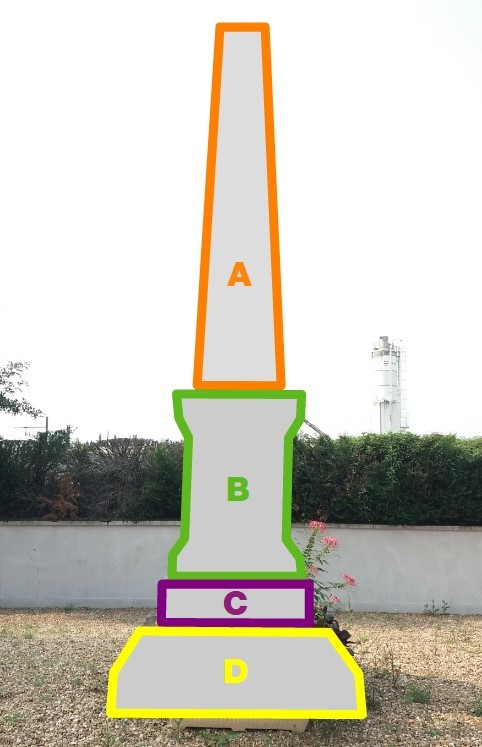
Informations de la fiche
1. Expliquez en quelques mots où, quand et comment s'est formée la pierre de Volvic.
2. Quelles caractéristiques de la roche la rendent intéressante pour la construction ou la sculpture?
3. Quelle caractéristique de la roche fait d'elle le support idéal pour la réalisation d'objets par technique d'émaillage?
4. Quelle caractéristique de la roche permet l'infiltration de l'eau dans les nappes d'Auvergne, qui donneront ensuite naissance aux sources de l'eau minérale naturelle Volvic? A quoi est due cette caractéristique?
Informations de la fiche + Observation du monument
5. Quelles parties du monument (A, B, C et/ou D) sont en pierre de Volvic?
6. Décrivez la roche comme vous l'observez. Cela correspond t-il aux caractéristiques physiques décrites dans la fiche?
7. Observez le monument dans sa globalité. Considérez-vous que la pierre de Volvic est absolument incassable, comme décrit dans la fiche?
Optionnel, mais apprécié : Joindre au log une photo de vous, d’un objet fétiche ou de votre pseudo dans l’environnement de la cache.
Loguez cette cache "Found it" et envoyez-moi vos propositions de réponses soit via mon profil, soit via la messagerie geocaching.com (Message Center). Vous aurez un petit retour de ma part pour confirmer ou infirmer vos réponses.
Les logs qui ne seront pas accompagnés de ce message privé seront automatiquement supprimés.
Merci de ne pas indiquer de réponse(s) dans votre log et de ne pas joindre de photo(s) spoilante(s).
Sources:
- https://volcan.puy-de-dome.fr
- https://coursgeologie.com
- https://www.gereve63.net
- https://www.chainedespuys-failledelimagne.com
- https://www.adelinedeponcins.com
Et Merci aux Passab de m'avoir fait découvrir cette stèle avec leur cache "Monument de la Sablière" que vous ne manquerez évidemment pas de trouver.

GENERAL PRESENTATION
Here you are facing the Sablière ossuary monument, the first erected in homage to the soldiers of the French army during the Franco-German war of 1870-1871, and intimately linked to the battles that took place here on October 11, 1870. If you want more historical information, you will find an information board in front of the monument.
But then, why an earthcache at this place ??? Well, the rock used to make the stele is not at all common in our region… it comes from the Puys chain, in Auvergne-Rhône-Alpes!
THE CHAIN OF PUYS
The Chaîne des Puys is an alignment of 80 volcanoes that extends nearly 32 kilometers long and 4 kilometers wide.
Chain of Puys

As a result of the formation of the Alps, the earth's crust thinned, creating vast cracks under the Auvergne. The rocks then melted in places and formed magma. And it is through these cracks that it rose to the surface, thus creating volcanoes. Formed between 95,000 and 8,400 years ago, the Puys chain constitutes the youngest volcanic ensemble in mainland France. It is precisely because these volcanoes are young that they offer a wide variety of shapes. The volcanoes of the Chaîne des Puys have not had time to erode, their shapes have remained pure and easily interpretable.
Culminating at 1465 meters, the Puy de Dôme is the highest of them, but it is another Puy that we will be interested in for this earthcache...
PUY OF "NUGÈRE"
The Puy de Nugère is located to the north of the Puys chain, and peaks at 994 meters above sea level. It is the result of a succession of volcanic eruptions which occurred around 11,000 years ago, and which makes it a complex geological structure.
- Originally, this puy is made up of 3 Strombolian cones (volcanoes of the most widespread form : projections and lava flow around a crater) (Figure 1)
- But a magmatophreatic explosion (meeting of water with magma) partially pulverizes the main of these 3 cones (figure 2), and a lava lake appears in the crater that remained.
- The lava from the lake then spreads around, in the direction of Volvic (figure 3), and small Strombolian cones (new volcanoes) settle on the solidified surface of the lava lake, producing new flows.

And it’s this lava flow towards Volvic that interests us!
VOLVIC STONE
To be precise, this gigantic flow is a “trachy-andesite”, that is to say a volcanic rock of the alkaline series, intermediate between a trachybasalt and a trachyte. It’s a bit complex for the framework of this earth that I want to be accessible, so let’s aim for something simpler…
Volvic stone is a lava stone, characterized by its gray color. Its appearance is not common, because small gas bubbles trapped during cooling have left imperfections which finely disturb its smooth character.
Volvic Stone

In addition to its appearance, this stone is unique in its substance: indestructible, it resists water, frost, fire, compression, putrefaction and acids. It also has a low coefficient of expansion. This makes it a material of choice for constructions or sculptures. The small holes in the gas bubbles also make it easy to cut, carve and sculpt. And although it is light and porous, it is not fragile. It may seem surprising, but it doesn't burst when you work with it...
VOLVIC STONE USE
- The qualities mentioned above naturally pushed the people of Auvergne to use this rock in the construction of buildings. Its exploitation dates back to the 13th century, in particular with the construction of the Clermont-Ferrand cathedral, or several symbolic buildings of the city of Riom. In the 19th century, the exploitation of Volvic stone intensified and was exported. It is, for example, used as a curb in Paris.
Clermont-Ferrand Cathedral

- Volvic stone is also highly appreciated by sculptors for its texture and hardness. It has served the creation of works at all times, and is still used today by artists such as the artist Thierry Courtadon who has made it his favorite medium.
Volvic Stone Sculptures

Thierry Courtadon at left and right / Paul Natter in center
- More unusual, Volvic stone is also used for the production of utility or decorative plaques by enamelling technique : street plaques, orientation tables, kitchen worktops, wall coverings, panels and decorative sets interiors (even in the bathrooms of the Queen of England!) and exteriors... Enamelling is a technique which allows a support to be covered with a vitreous layer, by fixing the pigments to the support by firing at a temperature very high which is around 960 °C. Lava is the only type of stone that supports enamelling, and Volvic stone in particular because its melting point is around 1500°C. Here again, it is the particular characteristics of the stone which are at the origin of its use, and in particular its thermal resistance.
Objects made of enammeled lava

Note : The surface of the enamel has cracks (crackling effect), which can be explained by the fact that enamel has a coefficient of expansion greater than that of lava. When cooling, the difference in retraction leads to the appearance of this micro-cracking phenomenon.
FURTHER INFORMATIONS
- Volvic is also famous for its mineral water, and the rock that we study in this earthcache is no stranger to it. Indeed, due to its porosity, it constitutes a natural filter which lets rainwater flow to the water tables. Note that water acquires its mineral composition by passing through 6 layers of volcanic rocks, in 5 years!
- The Puy de la Nugère is not the most spectacular volcano in the Chaîne des Puys, but it is very important for the history of volcanology. It is indeed said that it is the cradle of volcanology... Imagine that in 1750, no one imagined that the domes of Auvergne were volcanoes! Returning from a trip that took him to Vesuvius, Jean-Etienne Guettard (Museum Curator specializing in geology) remains perplexed in front of a fountain in the town of Moulins made precisely of Volvic stone. This stone reminds him of others observed on the flanks of the Italian volcano and can therefore only be a volcanic rock.
His investigation quickly led him to Riom then to Volvic on the Nugère flow. His intuition is confirmed when he ends up climbing the Puy de Dôme and sees the perfect alignment of the Chaîne des Puys unfold before his eyes, he understands that these hills are in reality volcanoes! He even mentions the possibility of new eruptions in the Chaîne des Puys: volcanology had just been born thanks to the flows from the Puy de la Nugère.
RESOLUTION OF THE EARTHCACHE
For the resolution, you will have to answer a few theoretical questions (you will find everything in the description) then observe the stele. For this step, use the photo below which demarcates 4 parts of the monument.

Sheet information
1. Explain in a few words where, when and how the Volvic stone was formed.
2. What characteristics of the rock make it interesting for building or sculpting?
3. What characteristic of roch makes it ideal support for making objects using the enamelling technique?
4. What characteristic of the rock allows the infiltration of water into the Auvergne aquifers, which will then give rise to the sources of Volvic natural mineral water? What is this feature due to?
Fact sheet information + Observation of the monument
5. Which parts of the monument (A, B, C and/or D) are in Volvic stone?
6. Describe the rock as you observe it. Does it correspond to the physical characteristics described in the sheet?
7. Observe the monument as a whole. Do you consider that the Volvic stone is absolutely unbreakable, as described in the sheet?
Optional, but appreciated: Attach to the log a photo of you, a favorite object or your nickname in the cache environment.
Log this cache "Found it" and send me your suggested answers either via my profile or via geocaching.com messaging (Message Center). You will get a little feedback from me to confirm or deny your answers.
Logs that are not accompanied by this private message will be automatically deleted.
Please do not indicate any answer(s) in your log and do not attach any spoilery photo(s).
Sources:
- https://volcan.puy-de-dome.fr
- https://coursgeologie.com
- https://www.gereve63.net
- https://www.chainedespuys-failledelimagne.com
- https://www.adelinedeponcins.com
And thanks to Passab for introducing me to this stele with their cache "Monument de la Sablière" which you will obviously not fail to find.
v>